The 2015-16 season has come to an end for the Detroit Red Wings, as they were eliminated in five games against the Tampa Bay Lightning in the first round of the NHL playoffs. It marks the second consecutive season the Bolts eliminated the Wings, and the fourth time in five seasons that Detroit was unable to make it out of the first round.
Looking at the current state of the team, there are more questions than answers, but one thing is certain – this team needs a shakeup. While it’s unrealistic to expect a complete turnaround for the Red Wings, this week’s edition of The Grind Line explores some possible steps the team can take this offseason to right the ship.
Tony Wolak: Upgrade Team Systems
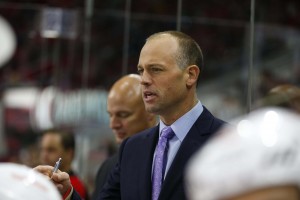
No, this doesn’t (necessarily) mean firing offensive and power play assistant coach Pat Ferschweiler. This past season, the Red Wings struggled to score. They also struggled collecting the puck in the defensive zone, transitioning, breaking it out, entering the offensive zone, and getting quality shots through. While Red Wings fans have been spoiled with spectacular teams in the past, the struggles this year are relative to 2015-16 NHL standards, not Red Wings past.
Now entering Year 2 of the Jeff Blashill Era, the Red Wings need to establish a more advanced system of play in all zones. And with defensive and penalty kill coach Tony Granato departing, the Red Wings have the opportunity to bring in additional wisdom to guide their weak defense and penalty kill. Perhaps NHL Network analyst and former All-Star defenseman Scott Stevens?
Regardless of who joins the coaching staff, Blashill will have another opportunity to mold the roster into what fits his ideal system. He has been working with a mostly Mike Babcock team, not one of his choosing.
One area Blashill will need to improve is the Red Wings’ lackluster transition game. After watching quick, transition teams like Pittsburgh and Washington dominate the league, the Red Wings could return to their roots and establish a similar style of game. Having strong puck movers like Danny DeKeyser, Niklas Kronwall, Brendan Smith, and Mike Green on the backend will greatly help the transition back to the transition game.
In addition, the Red Wings will need to shore up their special teams. Ranking in the middle of the pack—13th and 14th for power play and penalty kill, respectively—the Red Wings can definitely improve on those numbers, given the talent of their roster. Having another right-handed shot on the power play (hello, Teemu Pulkkinen) will help, as will crisper passing and better zone entries. The penalty kill will be much improved if the Red Wings return to a more aggressive style, recently featured during the 2014-15 season. Perhaps having more talented players like Dylan Larkin on penalty kill duty will help too. Chicago features Jonathan Toews on the PK, so why not Larkin?
Jacob Messing: Part Ways With the UFAs
Ken Holland’s first step to a successful offseason is to let all of the unrestricted free agent walk. Detroit’s five UFAs are on the wrong side of the youth movement and retooling process occurring in Detroit.
Joakim Andersson
Just when you think Andersson is gone, he reappears on the roster, either to kill penalties or play a fourth-line defensive role. At 27, Andersson is still young enough to find a home in the NHL, just no longer with the Red Wings.
With the great play of 21-year-old Andreas Athanasiou, Andersson has been replaced in all facets of the game. Moreover, given the strong free agency class this summer, there are plenty of better options on the market that can additionally replace Andersson’s mediocre skillset.
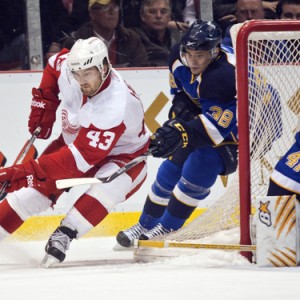
Darren Helm
Helm has a big following in Detroit, but his hands never could catch up to his speed, which often led to scoring chances but limited scoring. At the right price, Helm would be a solid piece to fill out the bottom six, but that’s just not how Blashill and company want to use him.
Instead he spent most of the season on a line with Pavel Datsyuk, wasting a spot next to a legend most nights. Meanwhile, more deserving players with better scoring touches were sheltered.
With the usage he would continue to receive, Holland has a chance to show his recent past of being over-loyal—see Dan Cleary—is yielding to smart business decisions.
Drew Miller
Miller had an unfortunate contact year, tearing his ACL in January and limiting his season to just 28 games. A solid penalty killer and back-to-back, league leader in blocked shots among forwards, Miller is the definition of a depth player.
But like Andersson, Miller has been replaced internally. Luke Glendening’s ability to kill penalties and read opposition makes him a strong utility player that comes faster, stronger and four years younger.
Even with Miller’s bad luck before signing a new contract, he’s still a solid depth player that will receive enough offers from other cities to give him options.
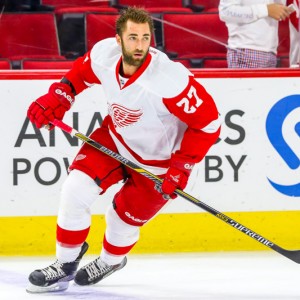
Kyle Quincey
In Detroit, Quincey is either loved or hated. He’s not an offensive defenseman but he has formed a solid partnership with Danny DeKeyser. Once Quincey discovered his role and settled into it, he has been one of Detroit’s most consistent defenders.
In this list, he stands as the most logical option for an extension. Detroit’s blue line has been stagnant since the departure of Nicklas Lidstrom and while there are better options come July 1st, the loss of Quincey and the potential for striking out in search of replacements would leave Detroit in an even worse position than it stands now.
If Quincey does sign a new contract in Detroit, Holland can’t be as open with money as he was two years ago when he struck out on James Wisniewski, Matt Niskanen, Dan Boyle and Anton Stralman. Money would be better off dedicated to a free agent list including but not limited to younger guys, Alex Goligoski, Keith Yandle and Luke Schenn.
Brad Richards
Richards is as good as gone. He was signed as a depth center before the emergence of natural centers Dylan Larkin and Andreas Athanasiou. Richards is too old to receive a new contract in Detroit. He performed admirably and chipped in a few key goals in Detroit’s feat of a 25th consecutive playoff appearance.
But now, after losing in the first round again, Richards will be replaced as the other UFAs mentioned in this list have been.
This may be the end of the road for the two-time Stanley Cup Champion. As mentioned, with a long list of free agents this summer, veterans have been getting washed out—see Curtis Glencross, 2015. The salary cap and turnover of aging players puts Richards in the position of what might become an unsurprising retirement announcement.
Brandon Peleshok: Promote From Within
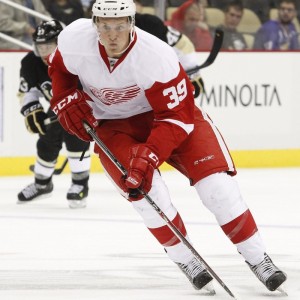
Ken Holland could make improvements to Detroit’s current roster several ways – free agency, trading and/or dipping into the prospect pool are all options for the Wings’ general manager. Recent history suggests that Holland is unlikely to make a blockbuster deal, and unless Holland can land a superstar-calibre player in Detroit, I’d rather see him avoid the free agent market.
For years now, we’ve witnessed several veteran players brought in through trade and free agency, only to see most of them fizzle out or fail to meet expectation. Letting the young, promising players on this team is something that will happen during the regular season, but avoiding middling, veteran players to serve as band-aids is something Holland can steer clear of this offseason.
However, letting those young players take on roles that are more prominent may not be an option for Kenny and company. It would appear as if Holland could have some pressure from above to turn things around in Motown this summer. In a piece for NHL.com, Nick Cotsonika outlines the Red Wings’ current situation:
“Ownership has given management no mandate to tear down the roster, so the Red Wings can miss the playoffs, bottom out, draft high and rebuild. Ilitch remembers when Detroit wasn’t known as “Hockeytown”; when he bought the team in the 1980s, the team had to give away cars to draw fans. He is building a new arena, set to open in 2017-18. He wants it to be full.”
Cotsonika brings up a valid point, and it’s likely going to influence the direction the Red Wings take this summer. It makes sense from a business standpoint, but is it better for the long-term health of the organization? As I mentioned above, if Holland can land a true superstar player (which this team desperately needs) then he should do what he can to make it happen. Considering the team’s current cap situation, however, he would have to get creative in order to do so.
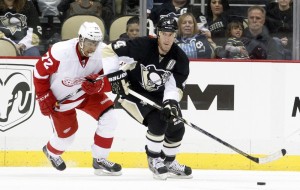
Perhaps the safest and most sensible route would be to allow some of the youth on this team a chance to shine. Dylan Larkin has already proven capable of being a key player for the Red Wings, and was given plenty of ice time to work with. Andreas Athanasiou, though constricted by his limited ice time, has proven he can make an offensive impact for the team, too. It’s likely that Anthony Mantha will be given the chance to land a permanent spot out of training camp next season, along with Xavier Ouellet on defense.
Having these players on the roster is a step in the right direction, but it’s only the first step. While it would be a mistake to push them into situations they are wholly unprepared for, the regression some of Detroit’s veteran players has become very apparent. While they shouldn’t plummet down the depth chart, reducing the roles and ice time of the Zetterbergs, Kronwalls and Ericssons of this team is something that needs to happen. It’s entirely possible that the best “additions” the Red Wings can make this offseason are already within their organization.